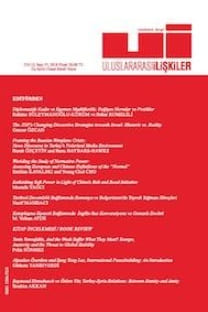Anarşi Devletler Ne Anlıyorsa Odur: Güç Politikalarının Sosyal İnşası
Bu makalede yazar “yeni-gerçekçi” ve “yeni-liberal” kuramların uluslararası anarşide kimlik ve çıkarların değişmez olduğuna yönelik savlarının aksine “inşacı” kuramın varsayımlarından yola çıkarak süreç odaklı alternatif bir sistem anlayışı önermektedir. Yazarın savunduğu bu inşacı anlayış literatürdeki genel kanıyı süreçlere vurgu yaparak sorgulamakta ve farklı olasılıklar sunmaktadır. Yazar ilk bölümde ana akım düşüncenin uluslararası sistemi nasıl tanımladığını ele almakta ve bu tanımlamalara alternatif olarak inşacı bir yaklaşımla sosyal süreçlerin kimlik ve çıkarları nasıl oluşturduğunu ve değiştirebildiğini incelemektedir. İkinci bölümde farklı yapıdaki devletleri ele alarak bu devletler arasındaki ilişkilerin nasıl oluştuğunu ve değişim geçirdiğini anlatan yazar bu ilişki sisteminin bir süreç olduğunu vurgulamaktadır. Üçüncü bölümde güvenlik, egemenlik gibi kavramları ele alarak devletler arasındaki ilişkilerin yapısını tanımlayan dinamikleri ele almaktadır. Sonuç kısmında ise yazar uluslararası ilişkiler sisteminin oluşumundaki sosyolojik dinamiklerin önemini ve bu dinamiklerin sistemi nasıl farklı yapılara dönüştürebileceğini savunmakta ve bu alternatif açıklamaların literatürde daha fazla yer alması gerektiğini savunmaktadır.
Anahtar Kelimeler:
İnşacılık, Anarşi, Güç Politikaları, Uluslararası Sistem.
Anarchy is What States Make of it: The Social Construction of Power Politics
In this article, contrary to “neo-realist” and “neo-liberal” arguments that identify identites and interest as given in the system, the author porposes an alternative system perception based on the hypotheses of “constuctivist” theory focusing on the processes. This constructivist explanation that the author defends questions the main consensus in the literature by emphasizing the proceses and provides alternative explanations. In the first part, the author presents the way main stream theories explain the system and as alternative to them he explores how social proceses create and transform identites and interests. In the second part, the author explains how inter-state relations are formed and transformed with the examples from different types of states and emphasize that this relationship system is a process. In the third part, the author discusses the dynamics that define the structure of international relations by exploring concepts like security and sovereignty. In the conclusion, the author argues that the social dynamics are important in creation of the international system and that these dynamics can transform the system into different structures and that these alternative explanations should be explored more in the literature.
Keywords:
Constructivism, Anarchy, Power Politics, International System,
___
- ......
- ISSN: 1304-7310
- Başlangıç: 2004
- Yayıncı: Uluslararası İlişkiler Konseyi Derneği İktisadi İşletmesi
Sayıdaki Diğer Makaleler
No One’s World: The West, The Rising Rest and the coming Global Turn
Senem Aydın-Düzgit, Constructions of European Identity: Debates and Discourses on Turkey and the EU
Anarşi Devletler Ne Anlıyorsa Odur: Güç Politikalarının Sosyal İnşası
Güvenlik Çalışmaları Serisi 1-10
Charles A. Kupchan, No One’s World: The West, The Rising Rest and the coming Global Turn
Üyeliğin Belirsiz Olduğu Durumlarda Avrupalılaşma: Türkiye’nin Enerji ve Çevre Politikaları
Çağrı YILDIRIM, Alper BAYSAN, Volkan Ş. EDİGER
John J. Mearsheimer, Liderler Neden Yalan Söyler? Uluslararası Politikada Yalan Gerçeği
Mustafa Aydın, Güvenlik Çalışmaları Serisi 1-10
